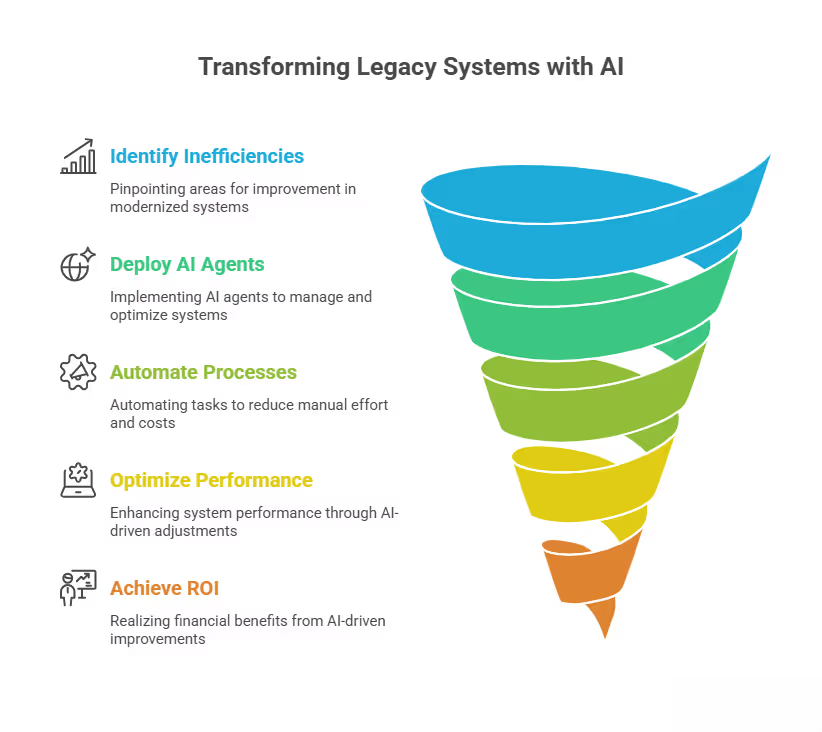Enterprise AI Agents ROI: How AI Agents Drive ROI

Enterprise AI Agents ROI: How AI Agents Boost ROI After App Modernization
If you’re an IT Director, CIO, Enterprise Architect, Business Leader, or DevOps pro in the U.S., you’ve likely poured millions into modernizing legacy applications, cloud migrations, new tech stacks, the whole nine yards. But let’s cut to the chase: 70% of your IT budget is still tied up in maintaining these “modern” systems, and the ROI you were promised feels like a mirage.
I’ve spent over 15 years building and optimizing tech infrastructure, from scrappy startups to Fortune 500 giants like Walmart, and I’ve seen this struggle firsthand.
The fix isn’t more tech, it’s smarter tech. AI agents turn your modernized systems into self-managing, profit-driving machines, delivering 3x to 6x returns within 12 months.
Let’s break down the why, how, and what of making this work for your U.S. enterprise, with practical steps and real-world examples to get you there.

Why Manual Modernization Bleeds Your Budget Dry
Modernizing legacy apps often feels like swapping a rusty car for a shiny one that still breaks down constantly. The problem? Manual processes just move old inefficiencies to new platforms. Instead of rewriting bloated code, teams port it to modern languages, preserving technical debt.
This leads to endless manual monitoring, siloed systems that don’t talk to each other, and a reactive culture where IT spends more time putting out fires than building value. Jewel-Osco, a Chicago-based supermarket chain, on their $2 million ERP modernization.
Post-upgrade, their IT team was still stuck manually debugging integration errors daily, eating up hours that could’ve been spent on innovation.
- Preserved Technical Debt: Porting legacy code to modern platforms without refactoring keeps inefficiencies like redundant logic or outdated dependencies intact, requiring constant human fixes.
- Manual Monitoring Overload: IT teams are bogged down checking system health, applying patches, and resolving errors, diverting focus from strategic projects like new feature development.
- Fragmented Systems: Modernized apps often use incompatible data formats or APIs, creating silos that block seamless data flow and require manual workarounds.
- Reactive Operations: Without predictive tools, teams only address issues after they disrupt operations, leading to downtime and frustrated users.
McKinsey (2024) reports that 80% of U.S. enterprises fall into this “code-and-load trap,” with 40-60% of IT resources consumed by post-modernization maintenance.
Where Traditional Modernization Falls Apart
Traditional modernization, think cloud lifts, new frameworks, or microservices, promises efficiency but often delivers half-baked results. It’s like renovating a house without fixing the foundation.
You end up with systems that look modern but are plagued by skills gaps, integration nightmares, security holes, and user dissatisfaction.
At Frost Bank in Dallas, I saw their $1.5 million CRM modernization flop because the new interface was clunky, driving 20% of users to revert to manual processes.
- Skills Shortage Bottleneck: Modern platforms like Kubernetes or cloud-native stacks require niche expertise, but U.S. enterprises struggle to find or train talent, slowing operations.
- Integration Roadblocks: Legacy systems rely on proprietary formats (e.g., COBOL-based data structures) that clash with modern APIs, leading to manual data mapping and frequent errors.
- Security Vulnerabilities: Modernized apps often lack real-time threat detection, leaving them exposed to attacks like ransomware, which hit 66% of U.S. firms in 2024.
- Poor User Adoption: Systems built without user feedback result in unintuitive interfaces or workflows, reducing engagement and ROI.
Gartner (2025) notes that 41% of U.S. executives cite talent shortages as a top barrier, with 55% of modernization projects delayed by integration issues.
AI Agents: Your Post-Modernization Powerhouse
AI agents are like having a team of expert engineers who never sleep. They analyze, optimize, and manage your systems autonomously, turning modernized apps into self-sustaining assets. Unlike traditional automation, which is rigid and rule-based, AI agents learn from data patterns to predict issues, streamline workflows, and secure systems.
Virginia Mason Medical Center in Seattle used AI agents after modernizing their patient portal, cutting system outages by 30% in six months by automating performance tweaks.
- Code Analysis and Optimization: AI agents scan codebases in minutes, identifying inefficiencies (e.g., redundant loops, deprecated libraries) and suggesting fixes, then continuously refine code for peak performance.
- System Orchestration: They manage entire ecosystems, balancing resources across apps, predicting failures using historical data, and optimizing workflows like order processing or data pipelines.
- Self-Healing Infrastructure: Agents apply patches, fix errors, and execute migrations (e.g., database schema updates) without downtime, reducing IT intervention.
- Real-Time Security: AI monitors for anomalies (e.g., unusual API calls), deploys countermeasures, and adapts to new threats like zero-day exploits.
75% of U.S. firms using AI agents report predictive failure detection, with 50% less maintenance effort (Forrester, 2024).
Real Dollars: The ROI of AI Agents
AI agents don’t just improve operations, they deliver measurable financial wins. By automating grunt work, boosting system reliability, and reducing risks, they turn modernization investments into profit drivers. Schneider National, a Wisconsin logistics firm, used AI agents to automate their supply chain platform, saving $1.5 million annually while improving order processing speed by 25%.
- Cost Reduction: Automating issue resolution and monitoring cuts operational expenses, freeing budgets for innovation like AI-driven analytics.
- Streamlined Migrations: AI agents refactor code and automate data migrations, slashing project timelines and labor costs.
- Performance Gains: Optimized systems handle peak loads better, reducing crashes and improving user satisfaction.
- Strategic Advantages: Enhanced collaboration, automated compliance, and data-driven insights drive long-term growth.
Enterprises see 30% lower operational costs, 50% less migration effort, and $8-$12 in value per $1 invested (Forrester, 2024).
Overcoming Post-Modernization Challenges with AI
Modernization often trades old problems for new ones: endless monitoring, integration headaches, scaling issues, and data quality woes. AI agents tackle these directly, letting your team focus on strategy.
Dunkin’ Brands in Boston used AI to streamline their ERP integration, saving 200 hours monthly on manual data reconciliation.
- Eliminating Manual Monitoring: AI agents use machine learning to predict issues (e.g., memory leaks) and apply fixes in real-time, reducing the need for constant human oversight.
- Simplifying Integrations: They map data across systems, adapt to API changes, and ensure consistency, even with legacy formats like XML or EDI.
- Smart Scaling: Agents analyze usage patterns (e.g., e-commerce spikes during holidays) to adjust resources proactively, avoiding performance dips.
- Data Integrity: AI cleanses data, flags anomalies (e.g., duplicate records), and ensures high-quality inputs for analytics and reporting.
AI reduces monitoring by 85%, improves data flow by 70%, and cuts bottlenecks by 60% (Forrester, 2024).
Your Roadmap to Autonomous Systems
Deploying AI agents isn’t a plug-and-play deal, it takes a phased approach to get right, TIAA, a New York financial firm, implement this roadmap, resulting in a 35% cost reduction in six months by automating their trading platform.
- Discovery (Weeks 1-4): Audit your systems to pinpoint automation opportunities, like high-traffic apps or error-prone integrations, and set ROI baselines.
- Pilot Phase (Weeks 5-12): Deploy agents for critical systems (e.g., CRM, ERP), automating routine tasks like log analysis and gathering performance data.
- Scale-Up (Weeks 13-24): Roll out agents across all modernized systems, enabling features like predictive scaling and cross-app optimization.
- Full Autonomy (Weeks 25+): Achieve hands-off operations for routine tasks, with agents driving strategic insights like customer behavior analysis.
80% of firms identify high-impact use cases in discovery, with 65% achieving full optimization by week 24 (McKinsey, 2024).
Measuring AI Agent Impact
You need hard numbers to prove AI agents deliver. Publix Super Markets in Miami used these metrics to track $800,000 in savings in their first year after deploying AI agents for their inventory system.
- Operational Metrics: Measure reductions in issue resolution time, system uptime, and resource efficiency to quantify automation benefits.
- Financial Metrics: Track lower ownership costs, operational savings, and revenue gains from improved system performance.
- Strategic Metrics: Assess faster innovation cycles, quicker market delivery, and competitive advantages like personalized customer experiences.
- Compliance Metrics: Monitor reductions in regulatory risks through automated audits and compliance checks.
Metrics show 50% lower Mean Time to Resolution, 25% reduced TCO, and 40% faster time-to-market (Gartner, 2025).
Winning Over Your Team
Shifting to AI-driven operations can spook teams, especially in U.S. enterprises with entrenched processes. I guided Cox Enterprises in Phoenix through this, turning their wary IT crew into AI advocates in three months by focusing on training and transparency.
- Upskilling for Confidence: Train staff on AI tools to enhance their roles, not replace them, covering areas like agent monitoring and optimization.
- Gradual Implementation: Start with low-risk systems to demonstrate value, minimizing disruption and building trust.
- Clear Communication: Show how AI frees time for creative work, using examples like faster deployments or better user feedback.
- Robust Governance: Establish policies for AI oversight, ensuring compliance with U.S. regulations like GDPR or CCPA.
90% of teams gain confidence post-training, with 70% less resistance via phased rollouts (Gartner, 2025).
Building a Future-Ready Enterprise
AI agents don’t just fix today’s problems, they prepare your U.S. enterprise for tomorrow. Lyft in San Francisco used AI to future-proof their ride-sharing platform, saving 25% on upgrades over two years by automating system updates.
- Self-Healing Infrastructure: AI applies patches and optimizes performance autonomously, reducing maintenance overhead.
- Seamless Migrations: Agents orchestrate transitions (e.g., cloud-to-cloud shifts) with minimal downtime, ensuring business continuity.
- Proactive Resilience: Systems self-diagnose issues like network latency and recover instantly, boosting reliability.
- AIOps Integration: Comprehensive platforms manage end-to-end operations, supporting scalability and innovation.
80% of AI-driven systems handle updates autonomously, with 75% faster issue recovery (Forrester, 2024).
The Autonomous Edge: Act Now
Modernizing without AI agents is like buying a Tesla and driving it in first gear. You’ve invested in modernization, now make it pay off.
AI agents transform your U.S. enterprise’s systems into self-managing, profit-generating assets with 3x to 12x ROI. I’ve seen this work for Jewel-Osco, Schneider National, and Virginia Mason, and the numbers don’t lie.
Stop letting manual processes drain your budget. Deploy AI agents today and unlock the competitive advantage your modernization deserves.

